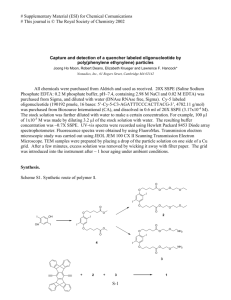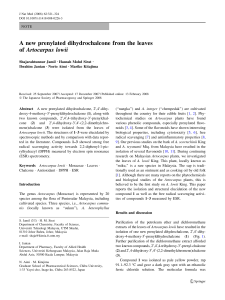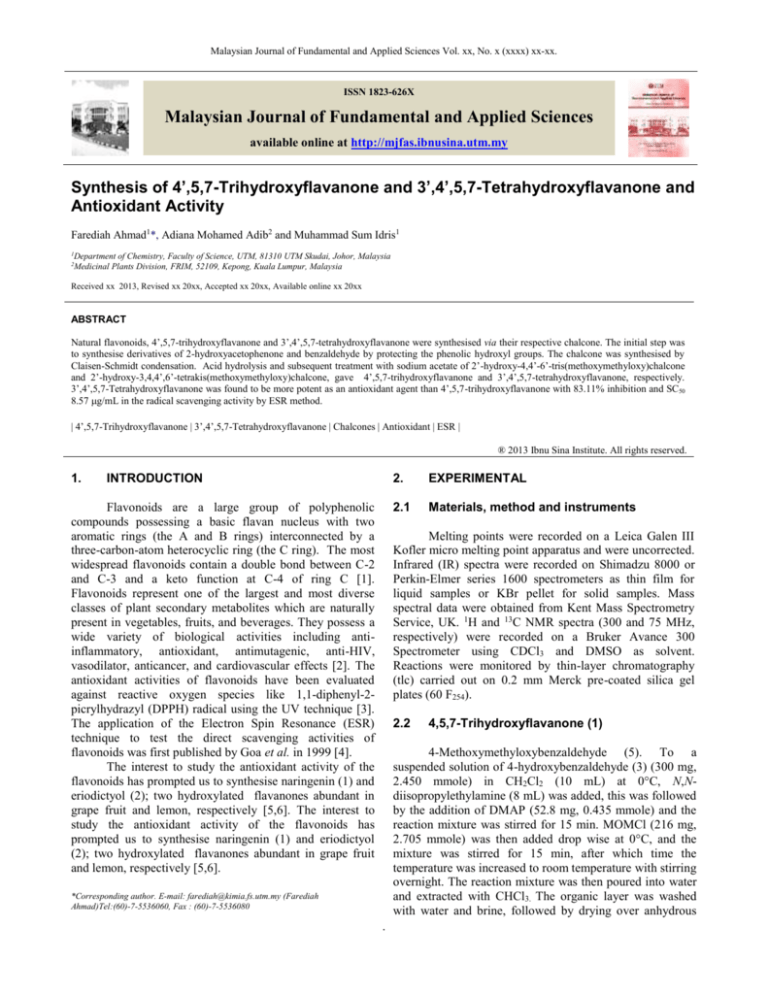
Malaysian Journal of Fundamental and Applied Sciences Vol. xx, No. x (xxxx) xx-xx.
ISSN 1823-626X
Malaysian Journal of Fundamental and Applied Sciences
available online at http://mjfas.ibnusina.utm.my
Synthesis of 4’,5,7-Trihydroxyflavanone and 3’,4’,5,7-Tetrahydroxyflavanone and
Antioxidant Activity
Farediah Ahmad1*, Adiana Mohamed Adib2 and Muhammad Sum Idris1
1
Department of Chemistry, Faculty of Science, UTM, 81310 UTM Skudai, Johor, Malaysia
Medicinal Plants Division, FRIM, 52109, Kepong, Kuala Lumpur, Malaysia
2
Received xx 2013, Revised xx 20xx, Accepted xx 20xx, Available online xx 20xx
ABSTRACT
Natural flavonoids, 4’,5,7-trihydroxyflavanone and 3’,4’,5,7-tetrahydroxyflavanone were synthesised via their respective chalcone. The initial step was
to synthesise derivatives of 2-hydroxyacetophenone and benzaldehyde by protecting the phenolic hydroxyl groups. The chalcone was synthesised by
Claisen-Schmidt condensation. Acid hydrolysis and subsequent treatment with sodium acetate of 2’-hydroxy-4,4’-6’-tris(methoxymethyloxy)chalcone
and 2’-hydroxy-3,4,4’,6’-tetrakis(methoxymethyloxy)chalcone, gave 4’,5,7-trihydroxyflavanone and 3’,4’,5,7-tetrahydroxyflavanone, respectively.
3’,4’,5,7-Tetrahydroxyflavanone was found to be more potent as an antioxidant agent than 4’,5,7-trihydroxyflavanone with 83.11% inhibition and SC50
8.57 g/mL in the radical scavenging activity by ESR method.
| 4’,5,7-Trihydroxyflavanone | 3’,4’,5,7-Tetrahydroxyflavanone | Chalcones | Antioxidant | ESR |
® 2013 Ibnu Sina Institute. All rights reserved.
1.
INTRODUCTION
Flavonoids are a large group of polyphenolic
compounds possessing a basic flavan nucleus with two
aromatic rings (the A and B rings) interconnected by a
three-carbon-atom heterocyclic ring (the C ring). The most
widespread flavonoids contain a double bond between C-2
and C-3 and a keto function at C-4 of ring C [1].
Flavonoids represent one of the largest and most diverse
classes of plant secondary metabolites which are naturally
present in vegetables, fruits, and beverages. They possess a
wide variety of biological activities including antiinflammatory, antioxidant, antimutagenic, anti-HIV,
vasodilator, anticancer, and cardiovascular effects [2]. The
antioxidant activities of flavonoids have been evaluated
against reactive oxygen species like 1,1-diphenyl-2picrylhydrazyl (DPPH) radical using the UV technique [3].
The application of the Electron Spin Resonance (ESR)
technique to test the direct scavenging activities of
flavonoids was first published by Goa et al. in 1999 [4].
The interest to study the antioxidant activity of the
flavonoids has prompted us to synthesise naringenin (1) and
eriodictyol (2); two hydroxylated flavanones abundant in
grape fruit and lemon, respectively [5,6]. The interest to
study the antioxidant activity of the flavonoids has
prompted us to synthesise naringenin (1) and eriodictyol
(2); two hydroxylated flavanones abundant in grape fruit
and lemon, respectively [5,6].
2.
EXPERIMENTAL
2.1
Materials, method and instruments
Melting points were recorded on a Leica Galen III
Kofler micro melting point apparatus and were uncorrected.
Infrared (IR) spectra were recorded on Shimadzu 8000 or
Perkin-Elmer series 1600 spectrometers as thin film for
liquid samples or KBr pellet for solid samples. Mass
spectral data were obtained from Kent Mass Spectrometry
Service, UK. 1H and 13C NMR spectra (300 and 75 MHz,
respectively) were recorded on a Bruker Avance 300
Spectrometer using CDCl3 and DMSO as solvent.
Reactions were monitored by thin-layer chromatography
(tlc) carried out on 0.2 mm Merck pre-coated silica gel
plates (60 F254).
2.2
4,5,7-Trihydroxyflavanone (1)
4-Methoxymethyloxybenzaldehyde (5). To a
suspended solution of 4-hydroxybenzaldehyde (3) (300 mg,
2.450 mmole) in CH2Cl2 (10 mL) at 0°C, N,Ndiisopropylethylamine (8 mL) was added, this was followed
by the addition of DMAP (52.8 mg, 0.435 mmole) and the
reaction mixture was stirred for 15 min. MOMCl (216 mg,
2.705 mmole) was then added drop wise at 0°C, and the
mixture was stirred for 15 min, after which time the
temperature was increased to room temperature with stirring
overnight. The reaction mixture was then poured into water
and extracted with CHCl3. The organic layer was washed
with water and brine, followed by drying over anhydrous
*Corresponding author. E-mail: farediah@kimia.fs.utm.my (Farediah
Ahmad)Tel:(60)-7-5536060, Fax : (60)-7-5536080
.
Malaysian Journal of Fundamental and Applied Sciences Vol. xx, No. x (xxxx) xx-xx.
4’,5,7-Trihydroxyflavanone (1). To 2’-hydroxy4,4’,6’-tris(methoxymethyloxy)chalcone (9) (113 mg, 0.279
mmol) in MeOH (6 mL) was added HCl (10%) (1 mL) and
the mixture was refluxed for 1.5 h. Then NaOAc (406 mg,
4.850 mmole) was added and the resulting mixture was
refluxed for 3 h. The mixture was cooled and H2O (25 mL)
was added and extracted with EtOAc (30 mL x 2), dried
over anhydrous MgSO4, filtered, and evaporated to dryness
to yield the targeted compound, 4’,5,7-trihydroxyflavanone
(1) (64.5 mg, 85.1%) as a brown solid with m.p 250-252°C
(lit.[7]248-251°C) and Rf0.33 (PE: EtOAc, 1: 4); IR ν max
(KBr) cm-1: 3300-3200 (-OH), 1636 (C=O), 1600.0 and
1460 (C=C aromatic) and 1158 (C-O); UV λmax (MeOH)
nm: 330 (shoulder), 289; NaOH; 324, 245; AlCl 3; 379, 310;
AlCl3/HCl; 379, 310; NaOAc; 324; NaOAc/H3BO3; 331
(sh), 289; NMR δH (DMSO) ppm: 2.67 (1H, dd, J= 17.1 and
3.0 Hz, H-3), 3.26 (1H, dd, J= 17.1 and 12.6 Hz, H-3), 5.43
(1H, dd, J=12.6 and 3.0 Hz, H-2), 5.84 (2H, s, H-6 and H8), 6.69 (2H, d, J= 6.3 Hz, H-2’ and H-6’), 7.30 (2H, d, J=
6.3 Hz, H-3’ and H-5’), 9.60 (1H, s, -OH), 10.81 (1H, s, OH), 12.13 (1H, s, -OH); CIMS: m/z 272 [M+, C15H12O5,
(100)].
MgSO4. The solvent was evaporated under reduced
pressure, and the resulting syrup was chromatographed on
a silica gel column (PE: EtOAc, 9: 1) to give 4methoxymethyloxybenzaldehyde (5) (377 mg, 93.0%) as a
colourless liquid with Rf 0.56 (PE; EtOAc, 1:4); IR νmax
(film) cm-1: 1689 (C=O), 1600 and 1507 (aromatic C=C),
1311 (C-O) ; NMR δH (CDCl3) ppm: 3.49 (3H, s, -OCH3),
5.26 (2H, s, -OCH2-), 7.16 (2H, d, J= 6.9 Hz, H-3 and H-5),
7.85 (2H, d, J= 6.9 Hz, H-2 and H-6) and 9.91 (1H, s, CHO).
2-Hydroxy-4,6-bis(methoxymethyloxy)cetophenone
(8).
To
a
suspended
solution
of
2,4,6trihydroxyacetophenone (7) (0.5 g, 2.976 mmole) in CH 2Cl2
(10 mL) at 0°C, N,N-diisopropylethylamine (6 mL) was
added, this was followed by the addition of DMAP (35.2
mg, 0.290 mmole) and the reaction mixture was stirred for
15 mins. MOMCl (175 mg, 2.170 mmole) was then added
drop wise at 0°C, and the mixture was stirred for 15 min,
after which time the temperature was increased to room
temperature with stirring overnight. The reaction mixture
was then poured into water and extracted with CHCl3 (2 x
20 mL). The organic layer was washed with water and brine,
followed by drying over anhydrous MgSO4. The solvent
was evaporated under reduced pressure, and the resulting
syrup was chromatographed on a silica gel column (PE :
EtOAc,
9:1)
to
give
2-hydroxy-4,6bis(methoxymethyloxy)acetophenone (8) (0.41 g, 53.8%) as
a colourless oil with Rf 0.69 (PE; EtOAc, 3: 2); IR νmax
(film) cm-1: 3443 (O-H), 1623 (C=O), 1599 and 1434 (C=C
aromatic); NMR δH (CDCl3) ppm: 2.67 (3H, s, -COCH3),
3.47 (3H, s, -OCH3), 3.53 (3H, s, -OCH3), 5.19 (2H, s, OCH2), 5.27 (2H, s, -OCH2-), 6.26 (1H, d, J= 2.2 Hz, H-5),
6.28 (1H, d, J= 2.2 Hz, H-3), 13.71 (1H, s, -OH).
2’-Hydroxy-4,4’,6’-tris(methoxymethyloxy)chalcone
(9).
To
a
solution
of
2-hydroxy-4,6bis(methoxymethyloxy)acetophenone (8) (141 mg, 0.553
mmole)
in
EtOH
(5
mL)
was
added
4methoxymethyloxybenzaldehyde (5) (101 mg, 0.6084
mmol) followed by addition of NaOH (30%) (0.9 mL). The
reaction mixture was left at room temperature for overnight.
After that, the reaction mixture was poured into iced water
and acidified with HCl (10%). The reaction mixture was
then poured into water and extracted with EtOAc. The
organic layer was washed with water and brine, followed by
drying over anhydrous MgSO4 and the solvent was
evaporated under reduced pressure. The resulting syrup was
chromatographed on a silica gel column (PE: EtOAc, 9: 1)
to give 2’-hydroxy-4,4’,6’-tris(methoxymethyloxy)chalcone
(9) (106 mg, 45.0%) as yellow crystals, m.p. 46-48°C and
Rf0.25 (PE: EtOAc, 3: 2); IR ν max (KBr) cm-1: 1600 and
1462 (C=C aromatic), 1622 (C=O), 1155.0 (C-O); NMR δH
(CDCl3) ppm: 3.45-3.55 (9H, 3x –OCH3), 5.17- 5.27 (6H,
3x -OCH2), 6.26 (1H, d, J= 2.1 Hz, H-3’), 6.33 (1H, d, J=
2.1 Hz, H-5’), 7.08 (2H, d, J= 9.0 Hz, H-3 and H-5), 7.57
(2H, d, J= 9.0 Hz, H-2 and H-6), 7.82 (1H, d, J= 10.2 Hz,
H-α), 7.87 (1H, d, J= 10.2 Hz, H-β), 13.9 (1H, s, -OH); (2H,
d, J= 9.0 Hz, H-2 and H-6), 7.82 (1H, d, J= 10.2 Hz, H-α),
EIMS: m/z 404 [M+, C21H24O8, (10)].
2.3
3’,4’,5,7-Tetrahydroxyflavanone (2)
3,4-Bis(methoxymethyloxy)benzaldehyde (6). To a
suspended solution of 3,4-dihydroxybenzaldehyde (4) (100
mg, 0.724 mmole) in CH2Cl2 (10 mL) at 0°C, N,Ndiisopropylethylamine (3 mL) was added, this was followed
by addition of DMAP (17.6 mg, 0.145 mmole) and the
reaction mixture was stirred for 15 mins. MOMCl (175 mg,
2.170 mmole) was then added drop wise at 0°C, and the
mixture was stirred for 15 min, after which time the
temperature was increased to room temperature with stirring
overnight. The reaction mixture was then poured into water
and extracted with CHCl3 (2 x 20 mL).The organic layer
was washed with water and brine, followed by drying over
anhydrous MgSO4. The solvent was evaporated under
reduced
pressure, and the resulting syrup was
chromatographed on a silica gel column (PE : EtOAc, 9: 1)
to give 3,4-bis(methoxymethyloxy)benzaldehyde (6) (139
mg, 75.1%) as a brown liquid with Rf 0.44 (PE: EtOAc,
4:1); IR νmax (film) cm-1: 1690 (C=O), 1595 and 1444
(C=C), 1262 (C-O); NMR δH (CDCl3) ppm: 3.53 (6H, s, OCH3), 5.31 (2H, s, -OCH2), 5.34 (2H, s, -OCH2-), 7.29
(1H, d, J= 8.2 Hz, H-5), 7.52 (1H, dd, J= 1.8 and 8.2 Hz, H6), 7.69 (1H, d, J= 1.8 Hz, H-2), 9.87 (1H, s, -CHO).
2’-Hydroxy-3,4,4’,6’-tetrakis (methoxymethyloxy)
chalcone (10). To a solution of 2-hydroxy-4,6bis(methoxymethyloxy)acetophenone (8) (111 mg, 43.440
mmole) in EtOH (5 mL) was added 3,4bis(methoxymethyloxy)benzaldehyde (6) (108 mg, 47.790
mmole) followed by addition of KOH (40%) (0.9 mL). The
reaction mixture was left at room temperature for overnight.
After that, the reaction mixture was poured into ice water
and acidified with HCl (10%). The reaction mixture was
then poured into water and extracted with CH2Cl2 (3 x 20
mL). The organic layer was washed with water and brine,
.
Malaysian Journal of Fundamental and Applied Sciences Vol. xx, No. x (xxxx) xx-xx.
followed by drying over anhydrous MgSO4 and the solvent
was evaporated under reduced pressure to produce syrup.
The resulting syrup was chromatographed on a silica gel
column (PE: EtOAc, 9: 1) to give 2’-hydroxy-3’,4’,4,6tetrakis(methoxymethyloxy)chalcone (10) (104 mg, 51.6%)
as yellow crystals, m.p. 88-90°C (lit [8] m.p. 91-92°C) and
Rf0.25 (PE: EtOAc, 3: 2); IR νmax (KBr) cm-1: 1625 (C=O),
1581 and 1353 (C=C olefinic), 1161 (C-O); NMR δH
(CDCl3) ppm: 3.55 (12H, m, -OCH3), 5.25 (8H, m, -OCH2),
6.29 (1H, d, J= 2.2 Hz, H-3’), 6.33 (1H, d, J= 2.2 Hz, H-5’),
7.19 (1H, d, J= 8.4 Hz, H-6), 7.23 (1H, d, J= 8.4 Hz, H-5),
7.53 (d, J= 1.5 Hz, H-2), 7.56 (1H, d, J= 15.6 Hz, H-α),
7.88 (1H, d, J= 15.6 Hz, H-β), 13.9 (1H, s, -OH); MS: m/z
464 [M+, C23H28O10, (10)].
3’,4’,5,7-Tetrahydroxyflavanone (2). To 2’-hydroxy3’,4’,4,6-tetrakis (methoxymethyloxy)chalcone (10) (0.05 g,
0.108 mmole) in MeOH (6 mL) was added HCl (1 mL) and
the mixture was refluxed for 1.5 h. Then NaOAc (0.18 g,
2.150 mmole) was added and then the resulting mixture was
refluxed for 3 h. The mixture was cooled and H 2O (25 mL)
was added and extracted with EtOAc (30 mL x 2), dried
over anhydrous MgSO4, filtered, and evaporated to dryness
to
afford
the
desired
product,
3’,4’,5,7tetrahydroxyflavanone (2) in 74.8% yield as brown solid
with m.p 194-196°C (lit. [9] 196-197°C) and Rf0.27 (PE:
EtOAc, 1: 4); IR νmax (KBr) cm-1: 3411 (OH), 1655 (C=O),
1608 (aromatic C=C) and 1264 (C-O); UV λmax (MeOH)
nm: 331 (shoulder), 288; NaOH; 322, 249; AlCl 3; 367 (sh),
309; AlCl3/HCl; 369 (sh), 309; NaOAc; 325, 288 (sh);
NaOAc/H3BO3; 323 (sh), 288; NMR δH (DMSO) ppm: 2.67
(1H, dd, J= 17.1 and 3.0 Hz, H-3a), 3.19 (1H, dd, J= 17.1
and 12.4 Hz, H-3b), 5.37 (1H, dd, J= 12.4 and 3.0 Hz, H-2),
5.87 (2H, s, H-6 and H-8), 6.73 (2H, s, H-5’ and H-6’), 6.87
(1H, s, H-2’), 9.04 (1H, s, -OH), 9.09 (1H, s, -OH), 10.80
(1H, s, -OH), 12.13 (1H, s, -OH); MS: m/z 287 [M-1,
C15H12O6, (7)].
2.4
Antioxidant
screening
scavenging activity)
(free
The SC50 value was determined as the concentration
of each sample required to give 50% of scavenging of
DPPH. All test and analyses were run in triplicates.
RESULTS & DISCUSSION
3.1
Synthesis 4’,5,7-trihydroxyflavanone (1)
Scheme 1.0 illustrates the detailed synthetic route to
(1) and (2). For both routes, the hydroxyl groups of
benzaldehydes (3 and 4) were protected by converting to the
MOM derivatives, (5) and (6), respectively. 4’,5,7Trihydroxyflavanone (1) or naringenin is the main
flavonoid compound found in grapefruit and has the
potential to act as an antitumorigenic [11] and antiinflammatory agents [5]. The synthesis of (1) was initiated
by the preparation of protected benzaldehyde (5). 4Methoxymethyloxybenzaldehyde (5) was isolated in
excellent yield, 93.0% as a colourless liquid and has an IR
spectrum with absorption bands at 1689 cm-1 (C=O) and
1600 and 1507 cm-1 (C=C aromatic). The presence of MOM protecting group was confirmed by the protons
resonances at 3.49 (3H, s, -OCH3), 5.26 (2H, s, -OCH2-)
in the 1H NMR spectrum. 2,4,6-Trihydroxyacetophenone
(7) was converted to its methoxymethylether derivative. A
reaction of (7) with methoxymethylchloride (MOMCl) in
the presence of dimethylaminopyridine (DMAP) and N,Nethyldiisopropylamine in dry CH2Cl2 afforded (8) as
colourless oil in 53.8% yield. The Claisen-Schmidt
condensation of (5) and (8) under basic condensation
afforded
2’-hydroxy-4,4’,6’-tris(methoxymethyloxy)
chalcone (9). The EIMS of (9) gave a molecular ion peak at
m/z 404 corresponding to C21H24O8. The absence of a
hydroxyl absorption band was noticed in the IR spectrum,
but its presence was later deduced from a broad band
phenolic proton signal at 13.9 in the 1H NMR spectrum. A
set of mutually coupled protons at 7.82 (1H, d, J = 10.2
Hz, H-), 7.87 (1H, d, J = 10.2 Hz, H-) confirmed the
formation of chalcone (9).
Deprotection of the MOM group of chalcone (9) was
achieved by using HCl (10%) in MeOH and cyclisation was
carried out in NaOAc/MeOH to furnish (1) as brown solids
in 85.1% yield. The IR spectrum displayed a broad
absorption band at 3300-3200 cm-1 attributable to the
hydroxyl group. The UV spectrum showed characteristics
absorption for a flavanone at 330 (band I) and 289 (band II)
nm. A bathochromic shift of 35 nm was noted for band II
after an addition of NaOH and NaOAc shift reagents,
indicating a 5,7-OH flavanone [12]. The CIMS spectrum
showed a molecular ion peak at m/z 272 which was in
accordance with the molecular formula C15H12O5. The 1H
NMR spectrum displayed typical ABX splitting pattern for
a flavanone at 2.67 (1H, dd, J = 17.1 and 3.0 Hz, H-3a),
3.26 (1H, dd, J = 17.1 and 12.6 Hz, H-3b) and 5.43 (1H, dd,
J = 12.6 and 2.7 Hz, H-2). The phenolic protons were
observed at 12.13 (1H, H-5), 10.81 (1H, H-7) and 9.60
(1H, H-4’). The IR spectrum displayed stretching bands for
radical
DPPH radical scavenging using ESR (Electron Spin
Resonance) was carried out according to the method
described by Ohtani et al. [10] with some minor
modifications. The ethanolic solution of the test sample 200
μL (1mg/mL) was added to 200μL of DPPH (0.25 mM) in
ethanol solution. After shaking vigorously for 10 sec, the
solution was transferred to a flat cell. The ESR spectra were
recorded after 40 sec. The condition of ESR spectrometer
were set at room temperature, power 1mW, magnetic field
336.000 ± 5mT, field modulation width 0.5 mT, sweep time
30 sec and time constant 0.03 sec. The scavenging effect of
DPPH was calculated by the following formula:
PH DPPH- PH Sample
x 100
Percent Scavenging (%) =
3.
PH DPPH
PH= Peak height of the third and the fifth line signals of
DPPH radical.
.
Malaysian Journal of Fundamental and Applied Sciences Vol. xx, No. x (xxxx) xx-xx.
–OH at 3443 cm-1 and a carbonyl at 1623 cm-1. The 1H
NMR spectrum of (8) showed the presence of signals due to
methylene protons at 3.47 (3H) and 3.53 (3H), which
HO
proved that (7) has been protected. The phenolic proton
resonated as a singlet at 13.71.
MOMO
a
H
R
O
O
5R=H
6 R = OMOM
3R=H
4 R = OH
HO
MOMO
OH
OH
6
b
a
OH
H
R
O
O
MOMO
OMOM
MOMO
OH
MOMO
8
7
O
10
b 5
c
OMOM
MOMO
OH
MOMO
OMOM
OH
HO
O
O
OH
OH
O
9
2
c
OH
HO
O
OH
O
1
Scheme 1 MOMCl, DMAP, Net(i-Pr)2, dry CH2Cl2, 24 h, 0oC, rt; (b) KOH 40%, EtOH, rt, 72 h; (c) i. HCl 10%, MeOH; ii.
NaOAc, reflux 3 h.
3.2
hydroxychalcone moiety with a downfield signal at 13.9
for phenolic O-H and a set of trans-olefinic protons at
7.56 (d, J = 15.6 Hz) and 7.88 (d, J = 15.6 Hz) for H- and
H-, respectively. The MS spectrum of (10) displayed a
molecular ion peak at m/z 464 which was in agreement with
a molecular formula C23H28O10.
Acid hydrolysis of chalcone (10) followed by
treatment with excessive NaOAc afforded 3’,4’,5,7tetrahydroxyflavanone (2) in a high yield (74.8%). The UV
spectrum of (2) displayed maximum absorption at 331
(shoulder) and 288 nm indicated the presence of a flavanone
skeleton. Addition of NaOH and NaOAc shift reagents
resulted in 34 and 36 nm bathochromic shift of band II,
which is typical of 5,7-dihydroxyflavanone [12]. Compound
Synthesis 3’,4’,5,7-Tetrahydroxflavanone (2)
Protection of (4) with MOMCl yielded 3,4bis(methoxymethyloxy)benzaldehyde (6) in 75.1% yield as
a brown liquid. The IR spectrum showed bands for carbonyl
(1690 cm-1), aromatic rings (1595 and 1444 cm-1) and C-O
(1262 cm-1). The presence of the protecting groups was
confirmed by the signals resonated at 3.53 (6H, s, -OCH3),
5.34 (2H, s, -OCH2) and 5.31 (2H, s, -OCH2-) in the 1H
NMR spectrum. The signal for the aldehyde proton
appeared at 9.87.
Condensation of (6) with (8) afforded 2’-hydroxy3,4,4’6’-tetrakis(methoxymethyloxy)chalcone (10). The 1H
NMR spectrum confirmed the formation of the
.
Malaysian Journal of Fundamental and Applied Sciences Vol. xx, No. x (xxxx) xx-xx.
(2) has the characteristic signals for a flavanone at 2.67
(1H, dd, J = 17.1 and 3.0 Hz, H-3a), 3.19 (1H, dd, J = 17.1
and 12.4 Hz, H-3b) and 5.37 (1H, dd, J = 12.4 and 3.0 Hz,
H-2) in the 1H NMR spectrum. The carbonyl group at C-4
forms hydrogen bonding with C-5 OH group, as evidenced
by a singlet which appeared at 12.13. The signals for the
remaining phenolic protons were seen at 9.04 (1H, H-3’),
9.09 (1H, H-4’) and 10.80 (1H, H-7). The aromatic protons
of the A-ring were observed overlapping as a singlet at
5.87 (2H, s, H-6 and H-8). The three aromatic protons of the
B-ring appeared at 6.87 (1H, s, H-2’) and 6.73 (2H, s, H5’ and H-6’). The MS spectrum showed a molecular ion
peak (M-1) at m/z 287 which was in agreement with the
molecular formula C15H12O6. The spectroscopic data of (2)
were in good agreement with the data of the same
compound published by Selenski [13]. Thus the synthesis of
3’,4’,5,7-tetrahydroxyflavanone or eriodictyol (2) was
completed in 15.8% overall yield.
3.3
Electron
Spin
spectrometry nethod
Resonance
(ESR)
In this study, the ESR spectrometry assay has been
used to measure the free radical scavenging activity of the
antioxidant against DPPH radical. Vitamin C was used as a
reference antioxidant and screened for comparison purposes
with the synthesised flavanones. Positive DPPH test
suggests that the tested compounds are free radical
scavengers.
An ESR signal is directly proportional to the number
of radicals present. The 0.25 mM DPPH radicals give a
typical ESR spectrum as shown in Figure 1.0. The peaks
height will be reduced when an antioxidant was added to the
ethanolic DPPH solution. The radical scavenging activity of
flavanones was expressed by means of SC50 which represent
the amount of antioxidant necessary to decrease the initial
DPPH concentration by 50%.
Table 1 The SC50 of the synthesised flavonoids by ESR spectrometry method
Sample
(1)
(2)
Vitamin C
SC50 (μg/mL)
(mean ± SD
77.340.3
8.570.8
10.91±0.4
Percent inhibition at 15.63 μg/mL
(mean ± SD)
31.85±0.2
83.112.4
80.19±1.9
(a)
(c)
(b)
(d)
Fig. 1 ESR spectra of scavenging effects of (b) 3’,4’,5,7-tetrahydroxyflavanone (2) (percent inhibition: 83.11%), (c) 4’,5,7trihydroxyflavanone (1) (percent inhibition: 31.85%), (d) vitamin C (percent inhibition: 80.19%) against (a) DPPH (0.25 mM)
free radical
Table 1.0 shows the activity of the tested
compounds. The radical scavenging activity of the active
compounds was found to be concentration-dependent
manner.
The
data
reveal
that
3’,4’,5,7tetrahydroxyflavanone (2) possess the strongest activity as
free radical scavenger compared with positive control,
vitamin C and flavanone (1), which can be seen from the
SC50 value of this compound; 8.57 μg/mL and 83.11%
inhibition at concentration 15.63 μg/mL. Figure 1.0shows
the intensities of the DPPH signal at concentration of 15.63
μg/mL for the flavanoids and vitamin C.
.
Malaysian Journal of Fundamental and Applied Sciences Vol. xx, No. x (xxxx) xx-xx.
Flavonoids with free hydroxyl groups are known to
scavenge free radicals by hydrogen donation. From the
results obtained above, the order of effectiveness in
scavenging DPPH radicals, also a measure of their
antioxidative potentials, is as follows:
ACKNOWLEDGEMENT
The authors thank the Department of Chemistry,
Faculty of Science and Ibnu Sina Institute, Universiti
Teknologi Malaysia, Johor for NMR facilities as well as to
Malaysian Government (FRGS) vot 78072 for funding the
project.
3’,4’,5,7-tetrahydroxyflavanone (2) > vitamin C > 4’,5,7trihydroxyflavanone (1)
An increase in the number of hydroxyl groups
generally enhances the antioxidant activity of the flavonoids
[14]. 3’,4’,5,7-Tetrahydroxyflavanone (2) which possess
3’,4’-dihydroxyl group in B-ring showed higher antioxidant
activity than4’,5,7-trihydroxyflavanone (1). The B-ring
which has the hydroxyl configuration is the most important
determinant of scavenging free radical. It was found that
flavonoids with the presence of catechol group in ring B
was essential for high antioxidant activity. 4’,5,7Trihydroxyflavanone (1)which lacked the orthodihydroxylation in the B ring reduced the radical
scavenging activity.
REFERENCES
[1]
[2]
[3]
[4]
[5]
[6]
[7]
4.
CONCLUSION
[8]
4’,5,7-Trihydroxyflavanone (1) and 3’,4’,5,7tetrahydroxyflavanone (2) were successfully prepared from
their
respective
chalcones,
2’-hydroxy-4,4’,6’tris(methoxymethyloxy)chalcone (9) and 2’-hydroxy3,4,4’,6’-tetrakis-(methoxymethyloxy)chalcone (10), in
excellent yields.
3’,4’,5,7-Tetrahydroxyflavanone (2)
exhibited high antioxidant activity than the standard,
vitamin C with SC50 values of 8.57 μg/mL compared to
4’,5,7-trihydroxyflavanone (1) with SC50 77. μg/mL in the
free radical scavenging activity against DPPH measured by
ESR technique.
[9]
[10]
[11]
[12]
[13]
[14]
.
T.A Geisman, Organic Chemistry of Secondary Plant Metabolites,
Freeman, Cooper and Company, California, 1969, 183-230.
A. Mohamed Adib, F. Ahmad, and M. S. Idris, J. Chem. Sci., 120
(2008) 1-5.
F. Neesa, Z, Ismail, N. Mohamed, and M. R. H. Haris, Food Chem.,
88 (2004) 243-252.
Z. Gao, K. Huang, X. Yang, and H. Xu, Biochim. Biophy. Acta.,
1472 (1999) 643-650.
J. A. Manthey, K. Grohman, and N. Guthrie, Curr. Med. Chem., 8
(2001) 135-153.
K. Minato, Y. Miyake, S. Fukumoto, K. Yamamoto, Y. Kato, Y.
Shimomura, and T. Osawa, Life Science, 72 (2003) 1609-1616.
R, Jain, S. Nagpal, J. Shweta, and S. C. Jain, J. Medicinal and
Aromatic Plant Species, 26 (2004) 48-50.
M. Hu, K. Kransz, J. Chen, G. X. Jun, J. Li, and H. Gelboin, Drug
Metabolism and Disposition, 31 (2003) 924-931.
Y. Xia, Z. Y. Yang, P. Xia, K. F. Bastow, Y. Nakanishi, and K. H.
Lee, Bioorg. Med. Chem. Lett, 10 (2000) 699-701.
Ohtani, N. Gotoh, J. Tanaka, T. Higa, M. A. Gyamfi, and Y. Aniya,
J. Nat. Prod, 63 (2000) 676-679.
S. M. Kuo, Cancer Lett, 110 (1996) 41-48.
K. R. Markham, Techniques of Flavonoids Identification,
Academic Press, London, 1982,
C. Selenski, and T. R. R. Pettus, Tetrahedron, 62 (2006) 52985307.
G. Cao, E. Sofic, and R. L. Prior, Free Radic, Biol. Med, 22 (1997)
749-760.

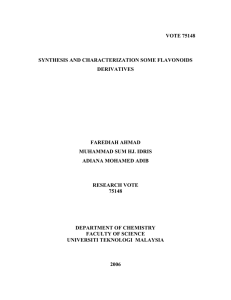
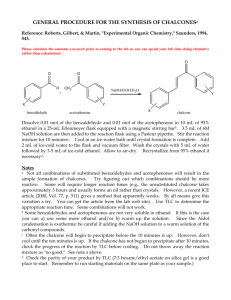
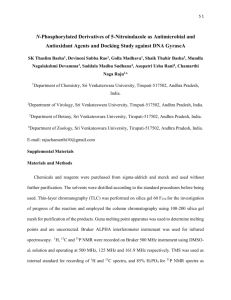
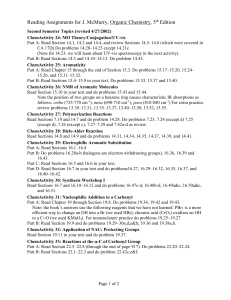
![benzo[d] isoxazole: In vitro Antimicrobial and Antioxidant activity](http://s3.studylib.net/store/data/007006684_1-684f7b1d721ca4abfe74cc96e54598b2-300x300.png)
